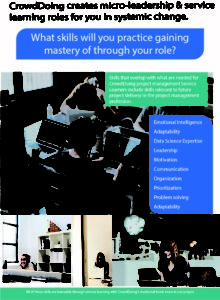Our Projects
Service Learning – A core CrowdDoing Principle
Service learning combines learning objectives with community service in order to provide a pragmatic, progressive learning experience while meeting societal needs. Service learning and skilled volunteering helps to bridge skill & social innovation gaps to achieve sustainable development goals. By practicing service learning and skilled volunteering we can collectively cope with a volatile, uncertain, ambiguous, and complex (VUCA) business landscape by leveraging under-utilized capacities which can drive new participation by individuals and institutions.
CrowdDoing aims to scale participation through skilled volunteering and service learning opportunities to help enterprises and institutions to foster social innovations. This approach is an efficient way for individuals to gain new skills that further their success as project managers, human resources professionals, marketing professionals, and engineers. Service learning focuses on social innovation can be efficient at both achieving a social impact, and at teaching skills needed in the future.




